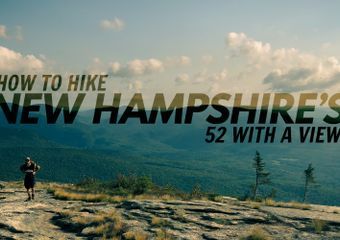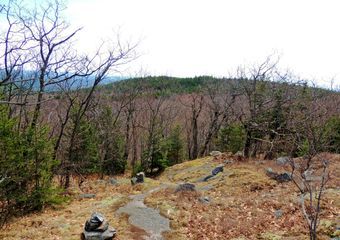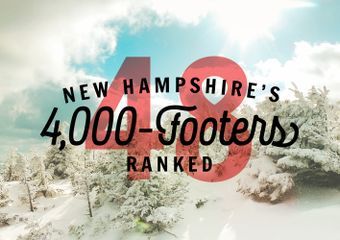A Quick Guide to the New England 100 Highest
As the temperature rises and the snow melts here in New England, the appearance of perennials and emergence of birds reminds us that yes, there is a life without bitter cold and mounds of ice and snow. For hikers, spring also brings the promise of summiting a high peak on a summer day, finding respite from the heat with a cool, mountain breeze, and relishing a spectacular valley vista thousands of feet below.
If you’re looking to summit as many of those beautiful New England peaks as possible, then you might try hiking the 100 highest in the region: the New England Hundred Highest.
The New England Hundred Highest (NE100) list is maintained and updated by the Appalachian Mountain Club (AMC) Four Thousand Footer Club, and as its name describes, includes the 100 highest peaks in New England. All of the peaks are located in the three northern New England states—Maine, New Hampshire, and Vermont. More specifically, the list includes all 4,000 footers in New England—48 in New Hampshire, 14 in Maine, and the lone five in Vermont. To round up to an even 100 and using the 200-foot col rule that also applies to the New Hampshire 4,000 footers (NH48), the AMC Four Thousand Footer Club added the next 33 highest mountains in New England.
New England 100 Highest Quick Facts
According to the AMC Four Thousand Footer Club, as of April 2018, 992 people have reported completing the NE100.
The most northern peak is Fort Mountain in Maine’s Baxter State Park, where you can hike to remnants from a 1944 plane crash.
The most southern peak is Stratton Mountain in Vermont, also a ski resort. If you drive from Fort Mountain to Stratton, it would take you approximately eight hours over roughly 450 miles.
Highest elevation: Mount Washington, 6,288 feet, in New Hampshire
Lowest elevation: Northeast peak of Cannon Ball, 3,769 feet, in New Hampshire
You may notice that this list does not include peaks in the three southern New England states of Massachusetts, Connecticut, and Rhode Island. Unfortunately, their elevations just don’t cut it.
Massachusetts: Mount Greylock, 3,491 feet.
Connecticut: Bear Mountain, 2,316 feet.
Rhode Island: Jerimoth Hill, 812 feet.
Appalachian Trail (AT) thru-hikers and section hikers may be interested to know that 24 peaks on the list are directly on the AT and several others are just off trail and an easy side trip.
New England 100 Highest State-by-State
New Hampshire
With the most peaks on the list, only 11 of New Hampshire’s 59 peaks are under 4,000 feet. Many hikers tackle the NH48 first before they take on the NE100. It’s a good place to start because once completed, you’re already almost halfway to completing the NE100.
Maine
Maine boasts 27 of the NE100 with just over half standing at 4,000 feet or more in elevation. While five of New Hampshire’s peaks stand taller than Maine’s highest peak on Katahdin—Baxter (5,268 feet)—it is by far one of the most iconic peaks on the list. Baxter is also the Northern Terminus of the Appalachian Trail.
Vermont
Fourteen of the NE100 are located in the beautiful state of Vermont. All of the peaks are located either on or near the Long Trail, a 263-mile continuous footpath that runs the length of the state from Massachusetts to the Canadian border.
How to Hike Them All
The Rules
According to the AMC Four Thousand Footer Club, you must complete each and every ascent and descent by foot. Skis and snowshoes are allowed, but no bikes. Hiking via auto road is a no-go (think Mount Washington auto road), but you can bag multiple peaks in one hike. Thirteen peaks do not have official trails and are reached via snowmobile trails, old logging roads, or herd paths. Expect some bushwhacking for these hikes as well.
The AMC Four Thousand Footer Club updates the NE100 list when new USGS maps are released. The committee also provides information sheets for routes and you can apply to be an official finisher by completing an application with your summit dates and a description of your final ascent. Of course, it’s not required that you apply and officially register for completion of the list, but you do receive a patch and certificate upon review of your application. Finishers are invited to attend the annual meeting and awards dinner.
Strategies
There are a few basic strategies for attacking the list. For most, this means planning day hikes to summit one, two, or sometimes three peaks at a time. Some of the mountains are within a mile or two of one another, so you can easily group a few peaks into one hike and make a day of it.
There’s also the option to go on a weekend (or longer) backpacking trip to bag several peaks in one go. For example, you could take on the Presidential Range and summit several peaks over a few days.
The most strenuous strategy would be to attempt the White Mountain Direttissima, at least for the NH48. In Italian, direttissima means “most direct route.” Taking on this challenge would mean attempting a 240 mile thru-hike of all 48 4,000-footers in the White Mountains.
Challenges
Peakbagging all 100 peaks can be a lengthy process. For some hikers, it takes several years to get around to summiting each and every peak. Others take on the challenge of completing the list in one calendar year. But really, you can decide how difficult or easy (a relative term) you want your peakbagging experience to be. You can keep to the summer and early fall months when the weather is warmer and trails are dryer. Or you can strap on your snowshoes and trudge through the deep snowpack in January and complete the winter list of the Four Thousand Footer Club.
As mentioned earlier, some trailheads are more difficult to access and you may encounter bushwhacking on the more remote trails; however, as peakbagging becomes more popular, it has become easier to find directions to remote trailheads and bushwhacking may not be extreme as it may have once been. Conditions can vary from year to year.
Of course, the duration of summer in the mountains is shorter, so there’s also a narrower window of time to summit snowless peaks. Many hikers do take on the NE100 in the winter, but bear in mind the extra equipment that may be needed for such an endeavor. Don’t rule out hiking in the fall, however. Many hikers find the cooler temperatures and vivid fall colors make this time of year the most enjoyable and rewarding of all.
Lastly, having hiked the mountains of New England for over 20 years, I can tell you that most are steep and committing to complete the NE100 is no easy task. You won’t find any extremely technical climbing, but you’ll want to be in solid physical shape, especially if you plan to tackle more than one peak per hike.
Beyond the NE 100
If checking the NE100 off your bucket list just isn’t enough, then have no fear. There’s an endless string of peakbagging lists to take on and the next level up from the NE100 is to complete the Northeast 111, which includes all 111 4,000 footers in the Northeast. Apart from the 67 peaks in New England, the Northeast 111 includes 44 peaks in the Adirondacks and Catskills in New York.
If you live in New England (or are planning an extended stay) and are looking for some weekend adventures to fill your calendar over the next few years, this might be the perfect list for you. Even if you don’t take on the list in any official capacity by registering your completion dates and filling out an application, peakbagging lists can be a great way to hike new mountains and even make a weekend out of it by exploring towns nearby. Whether winter, summer, spring, or fall, the New England Hundred Highest is sure to be a challenge, but a worthwhile one at that.
Looking for more lists to hike in New England? We’ve got you covered
This website contains affiliate links, which means The Trek may receive a percentage of any product or service you purchase using the links in the articles or advertisements. The buyer pays the same price as they would otherwise, and your purchase helps to support The Trek's ongoing goal to serve you quality backpacking advice and information. Thanks for your support!
To learn more, please visit the About This Site page.












